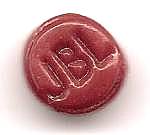So, Earl, you posit that the zero-crossing null between the two resonance peaks in the impedance curve correlates with F3 of the driver/waveguide combination, and their loading.
The Fmin is easily ascertained by WT2, either via Fs or Vented Box tests, and the F3 may be found from CLIO MLS measurement.
Here they are for the same 2431H driver on PT-H1010 and PT-F1010 waveguides, an interesting case, since they are so similar. Can your theory discriminate between these two?
Indeed. 
PT-H:Fmin = 1393 Hz
F3 = 1208 Hz (cursors)
PT-F:Fmin = 1162 Hz
F3 = 1099 Hz
PT-H impedance (red, phase is blue,) top, PT-F next. Note that the FR curves (bottom) nicely track those Mr. Widget did a year ago, above.... 






 Reply With Quote
Reply With Quote


 So off I go tomorrow to give them a call. It took me a while to figure out what they where. They are the 75X50 352606 from the SRX722's. I ordered the PTH1010's. So there a bit different. I am actually glad cause I wanted to try a horn out in this geometry. This is the first time I can actually listen to the 2431's and they sound like they could be quite nice. I have not done any comps just a series cap and a notch to get them smoothed a bit. Zilch I think you looked at there little brother. These are decent size. They are aluminum and ring like hells bells un mounted.
So off I go tomorrow to give them a call. It took me a while to figure out what they where. They are the 75X50 352606 from the SRX722's. I ordered the PTH1010's. So there a bit different. I am actually glad cause I wanted to try a horn out in this geometry. This is the first time I can actually listen to the 2431's and they sound like they could be quite nice. I have not done any comps just a series cap and a notch to get them smoothed a bit. Zilch I think you looked at there little brother. These are decent size. They are aluminum and ring like hells bells un mounted.
 . I laid the 2431 and 2435 side by side to see that the 2431 had part of the terminal block and rivet removed. I went to the grinder and took the edge off the terminal block to match the 2431's and they fit
. I laid the 2431 and 2435 side by side to see that the 2431 had part of the terminal block and rivet removed. I went to the grinder and took the edge off the terminal block to match the 2431's and they fit . I used the provided filter paper to remove the old ferrofluid and cleaned the gaps. Then put in the new fluid. That was fun as the gap flux sucked it right out of the tube!! I lined up the diaphrams and reinstalled the covers. Did a quick sweep at home and then tried some measurements with a preliminary network on the PTH1010 horns. To my surprise they looked very good and had much more extension up top then I thought I was going to get from them. Matter of fact a little too much which really surprised me looking at Widgets horn study and Project May Data. Attached are the Sine files with harmonic distortion both 2nd and 3rd and an overlay done with MLS to see how well they match up. I have not listened to them yet or finalized the network so I still have a bit of work to do.
. I used the provided filter paper to remove the old ferrofluid and cleaned the gaps. Then put in the new fluid. That was fun as the gap flux sucked it right out of the tube!! I lined up the diaphrams and reinstalled the covers. Did a quick sweep at home and then tried some measurements with a preliminary network on the PTH1010 horns. To my surprise they looked very good and had much more extension up top then I thought I was going to get from them. Matter of fact a little too much which really surprised me looking at Widgets horn study and Project May Data. Attached are the Sine files with harmonic distortion both 2nd and 3rd and an overlay done with MLS to see how well they match up. I have not listened to them yet or finalized the network so I still have a bit of work to do.